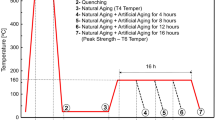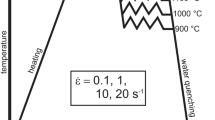Abstract
This paper deals with the short crack initiation of the material 9Cr-1Mo (P91) under cyclic loading at different temperatures (T = 24 °C and T = 650 °C) concluded with the estimation of the short crack initiation Wöhler (S/N) Curve. Short crack initiation under the influence of microstructures is analyzed to derive their crack initiation curves. An artificial but representative microstructural model microstructure was generated using the Voronoi tessellation (VT) method and the non-uniform stress distribution is calculated by Finite Element Method accordingly afterwards. The number of cycles needed for crack initiation is estimated on the basis of the stress distribution in the microstructural model by applying the physically-based Tanaka-Mura model (TMM). Since mechanical properties are highly correlated with temperature, the research indicates that the number of cycles required to initiate cracks at room temperature is significantly higher than at elevated temperatures.






Similar content being viewed by others
References
R.Y. Cui et al., Quantifying operational lifetimes for coal power plants under the Paris goals. Nat. Commun. 10, 1–9 (2019)
S. Salifu, D. Desai, S. Kok, Numerical investigation of creep-fatigue interaction of straight P91 steam pipe subjected to start-up and shutdown cycles. Mater. Today Proc. 38, 1018–1023 (2021)
M. Speicher, A. Klenk, and K. Coleman, Creep-Fatigue Interactions in P91 Steel. in 13th International Conference on Fracture, 16–21 June 2013 (China), p 1–10 (2013)
F. Bassi, S. Beretta, A. Lo Conte, and M. Cristea, Creep-Fatigue Crack Growth in Power Plant Components Contact data Key Words Material and Creep-fatigue tests, in 4th International ECCC Confrerence, 10–14 September 2017 (Germany), p 1–10 (2017)
A. Saxena and S. Narasimhachary, Creep-fatigue crack growth testing of p91 steel: result of the round robin for assessing ASTM Standard E-2760–10, EPRI, Palo Alto, CA, (2018)
A. Mehmanparast, M. Yatomi, F. Biglari, S. Maleki, K. Nikbin, Experimental and numerical investigation of the weld geometry effects on Type IV cracking behaviour in P91 steel. Eng. Fail. Anal. 117, 1–12 (2020)
M. Mlikota and S. Schmauder, Numerical determination of component Wöhler curve, Anwendungsspezifsche Werkstoffgesetze für die Bauteilsimulation, DVM-Bericht 1684, DVM e.V., Berlin, 26–28 April 2017 (Germany), p 111–124 (2017)
M. Mlikota, S. Schmauder, Ž Božić, Calculation of the Wöhler (S-N) curve using a two-scale model. Int. J. Fatigue. 114, 289–297 (2018)
M. Mlikota, Multiscale Modelling and Simulation of Metal Fatigue and its Applications. (Ph.D. Thesis. Universität Stuttgart, Stuttgart, 2020)
N. Jezernik, J. Kramberger, T. Lassen, S. Glodež, Numerical modelling of fatigue crack initiation and growth of martensitic steels. Fatigue Fract. Eng. Mater. Struct. 33, 714–723 (2010)
J. Kramberger, N. Jezernik, P. Göncz, S. Glodež, Extension of the Tanaka-Mura model for fatigue crack initiation in thermally cut martensitic steels. Eng. Fract. Mech. 77, 2040–2050 (2010)
X. Wu, On Tanaka-Mura’s fatigue crack nucleation model and validation. Fatigue Fract. Eng. Mater. Struct. 41(4), 894–899 (2018)
A. Brückner-Foit, X. Huang, Numerical simulation of micro-crack initiation of martensitic steel under fatigue loading. Int. J. Fatigue. 28, 963–971 (2006)
K. Tanaka, T. Mura, A dislocation model for fatigue crack initiation. J. Appl. Mech. 48(1), 97–103 (1981)
K. Tanaka, T. Mura, A theory of fatigue crack initiation at inclusions. Metall. Tarns. A. 13, 117–123 (1982)
J. Zhou, R.A. Barrett, S.B. Leen, A physically-based method for predicting high temperature fatigue crack initiation in P91 welded steel. Int. J. Fatigue. 153, 1–15 (2021)
G. Monnet, M.A. Pouchon, Determination of the critical resolved shear stress and the friction stress in austenitic stainless steels by compression of pillars extracted from single grains. Mater. Lett. 98, 128–130 (2013)
D.F. Li, B.J. Golden, N.P. O’Dowd, Multiscale modelling of mechanical response in a martensitic steel: a micromechanical and length-scale-dependent framework for precipitate hardening. Acta Mater. 80, 445–456 (2014)
ABAQUS 6.13, Theory Guide, Dassault Systemes Simula Corp, Providence, RI, USA.
ABAQUS 6.13, Scripting Reference Guide Dassault Systemes Simula Corp, Providence, RI, USA.
Y. Gorash and D. Mackenzie, Safety structural design for fatigue and creep using cyclic yield strength,in Conference: 3rd International ECCC Creep & Fracture ConferenceAt: Barceló Aran Mantegna Hotel, Rome, Italy, p 1–7 (2014)
H.J. Kim, Y.H. Kim, J.W. Morris, Thermal mechanisms of grain and packet refinement in a lath martensitic steel. ISIJ Int. 38, 1277–1285 (1998)
G. Sasikala, S.K. Ray, Evaluation of quasistatic fracture toughness of a modified 9Cr-1Mo (P91) steel. Mater. Sci. Eng. A. 479, 105–111 (2008)
K. Kaede, A. Jäger, V. Gärtnerová, C. Takushima, T. Yamamuro, S. Tsurekawa, Measurement of local mechanical properties of T91 steel corroded by molten lead-bismuth eutectic alloy via Micropillar compression test. MRS Adv. 3(8–9), 419–425 (2018)
Y. Kawabe, Data Sheets on the Elevated Temperature, Time-Dependent Low-Cycle Fatigue Properties of ASTM A387 Grade 91 (9Cr-1Mo) Steel Plate for Pressure Vessels. (National Research Institute for Metals, Tokyo, 1993)
V. Shankar, K. Mariappan, R. Sandhya, M.D. Mathew, Evaluation of low cycle fatigue damage in grade 91 steel weld joints for high temperature applications. Procedia Eng. 55, 128–135 (2013)
Acknowledgments
The authors would like to express their gratitude to staff members of the Institute for Materials Testing, Materials Science and Strength of Materials (IMWF) at the University of Stuttgart, Germany, the Smart Manufacturing Research Institute (SMRI) at School of Mechanical Engineering, Universiti Teknologi MARA (UiTM), Malaysia, the Department of Occupational Safety and Health (DOSH), Malaysia as well as NIMS for the use of the experimental data. This research is financially supported by the Public Service Department of Malaysia with reference number JPA(I)870614145415.
Author information
Authors and Affiliations
Corresponding author
Additional information
Publisher's Note
Springer Nature remains neutral with regard to jurisdictional claims in published maps and institutional affiliations.
This article is an invited paper selected from presentations at the 6th Symposium on Damage Mechanism in Materials and Structures (SDMMS 2022), held August 16–17, 2022 in Kuantan, Malaysia. The manuscript has been expanded from the original presentation. The special issue was organized by Nasrul Azuan Alang, Norhaida Ab Razak, and Aizat Alias, Universiti Malaysia Pahang.
Rights and permissions
Springer Nature or its licensor (e.g. a society or other partner) holds exclusive rights to this article under a publishing agreement with the author(s) or other rightsholder(s); author self-archiving of the accepted manuscript version of this article is solely governed by the terms of such publishing agreement and applicable law.
About this article
Cite this article
Rahim, M.R.A., Schmauder, S., Manurung, Y.H.P. et al. Cycle Number Estimation Method on Fatigue Crack Initiation using Voronoi Tessellation and the Tanaka Mura Model. J Fail. Anal. and Preven. 23, 548–555 (2023). https://doi.org/10.1007/s11668-023-01603-0
Received:
Revised:
Accepted:
Published:
Issue Date:
DOI: https://doi.org/10.1007/s11668-023-01603-0




